Abstract
OBJECTIVE--To follow up known intravenous drug users to determine current health state and drug use, compare characteristics with those of recent drug users, and examine HIV exposure and serostate. DESIGN--Subjects were identified from conventional general practice records and recruited from 1980 to the end of 1985; they were followed up during 1987 and 1988 and compared with drug users identified in the same way but recruited after 1985. SETTING--General practice and community in north west Edinburgh. Follow up conducted throughout the United Kingdom. SUBJECTS--Subjects known to have injected illegal drugs before 1986 (n = 203) and since that time. MAIN OUTCOME MEASURES--Mortality from and prevalence of HIV seropositivity and various parameters indicative of abstinence. RESULTS--Of the 203 subjects in the follow up group, 189 (93%) were traced; 16 (8%) had died and the remaining 173 (85%) were interviewed. In all, 146 (72% of the follow up cohort) had been tested for HIV antibodies, 94 (64%) having positive and 52 (36%) negative results; 57 (28%) had not been tested. Of the 65 subjects in the recently recruited group, 51 (79%) had been tested for HIV, 15 (29%) having positive results. A further 21 (43%) were currently negative for HIV antibody but still at risk. Thirty three (19%) of those followed up were confirmed abstinent, although more (about half) showed evidence of diminished drug injecting. Age correlated strongly with abstinence (p less than 0.001). One third of the group currently used cannabis, buprenorphine, dihydrocodeine, or diazepam. When the two groups were analysed together there was a strong association between the date of starting injecting and HIV seropositivity (chi 3 = 23.81, df = 2, p less than 0.001), with a peak around 1980-3. CONCLUSIONS--Although only a fifth of the followed up group were convincingly abstinent, a much larger group showed evidence of prolonged periods of remission. Overall, much use of oral drugs was confirmed and worrying trends towards taking buprenorphine and benzodiazepines were evident. The peak incidence of starting drug use and the comparatively low seroprevalence of HIV in the newer drug users probably explain the anomalous high seroprevalence in Edinburgh drug users during 1980-5. The epidemic of HIV during the first half of the 1980s in the group suggests that the virus was probably being transmitted because of a pattern of behaviour. Changing patterns of HIV transmission suggest a need to concentrate on heterosexual transmission as the main problem in the future.
Full text
PDF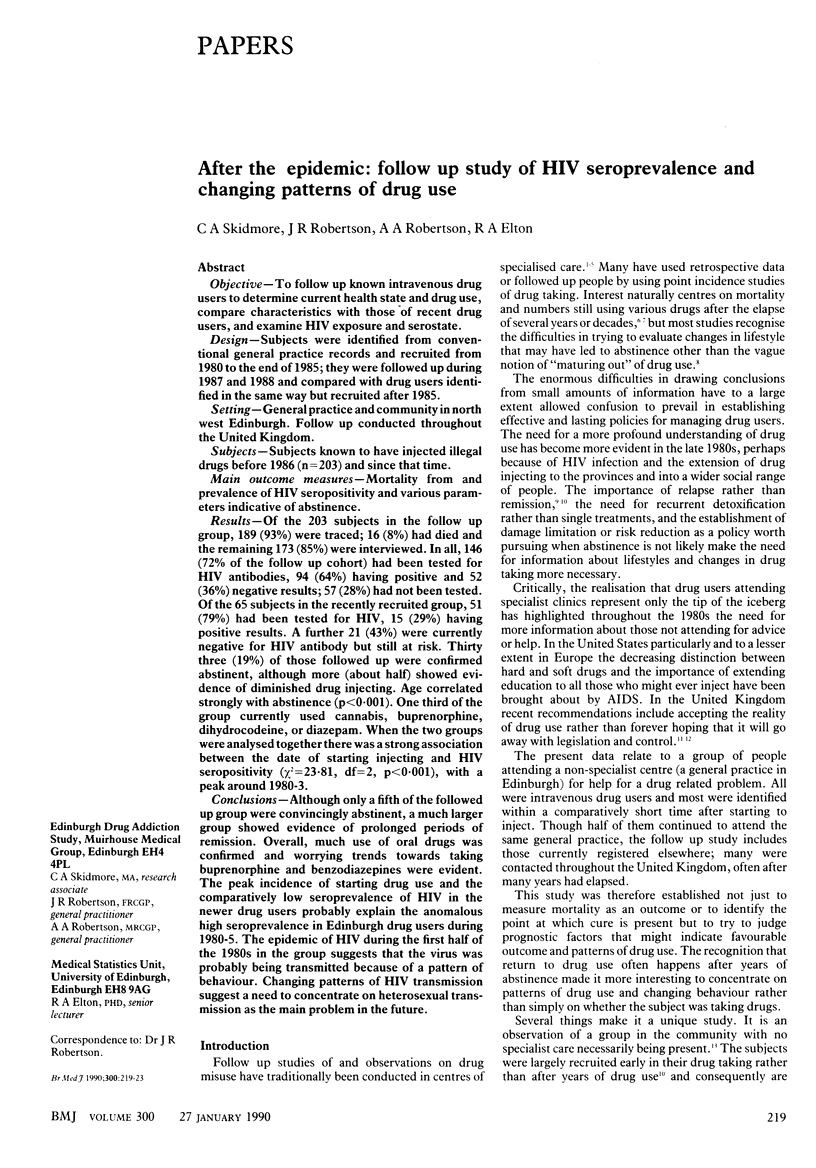
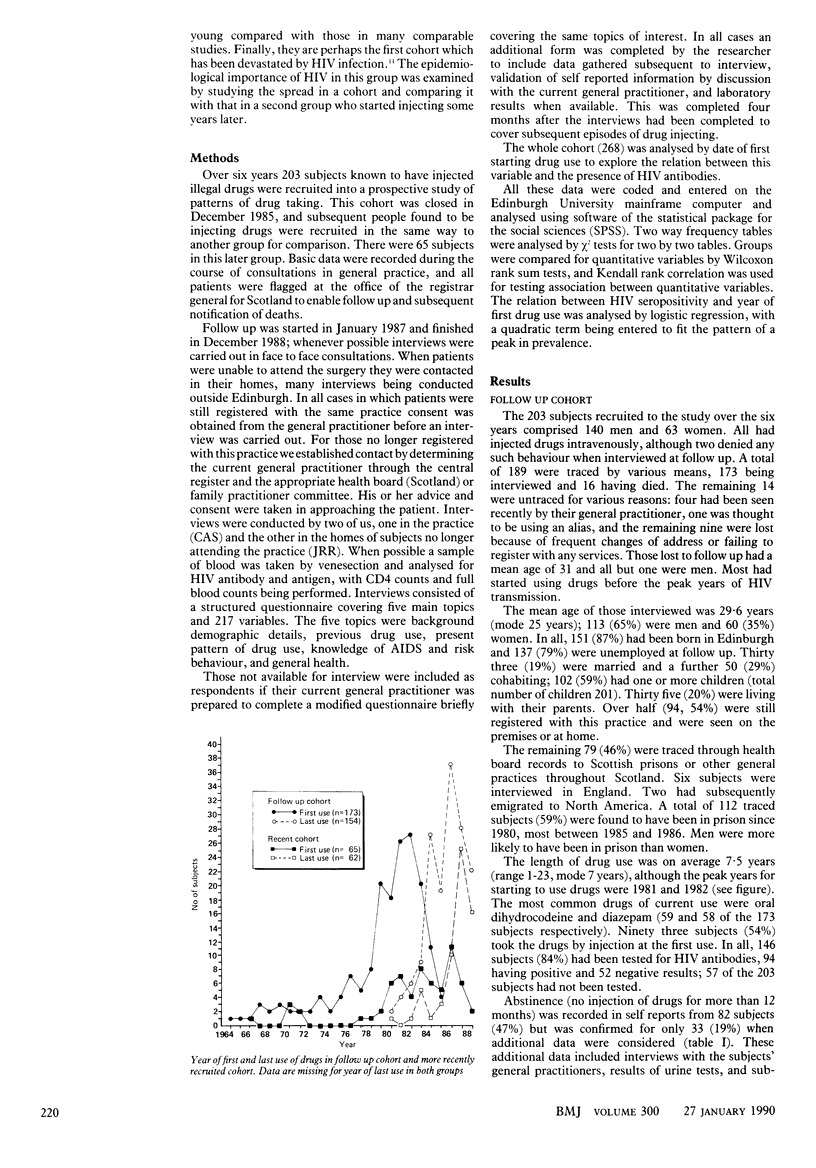
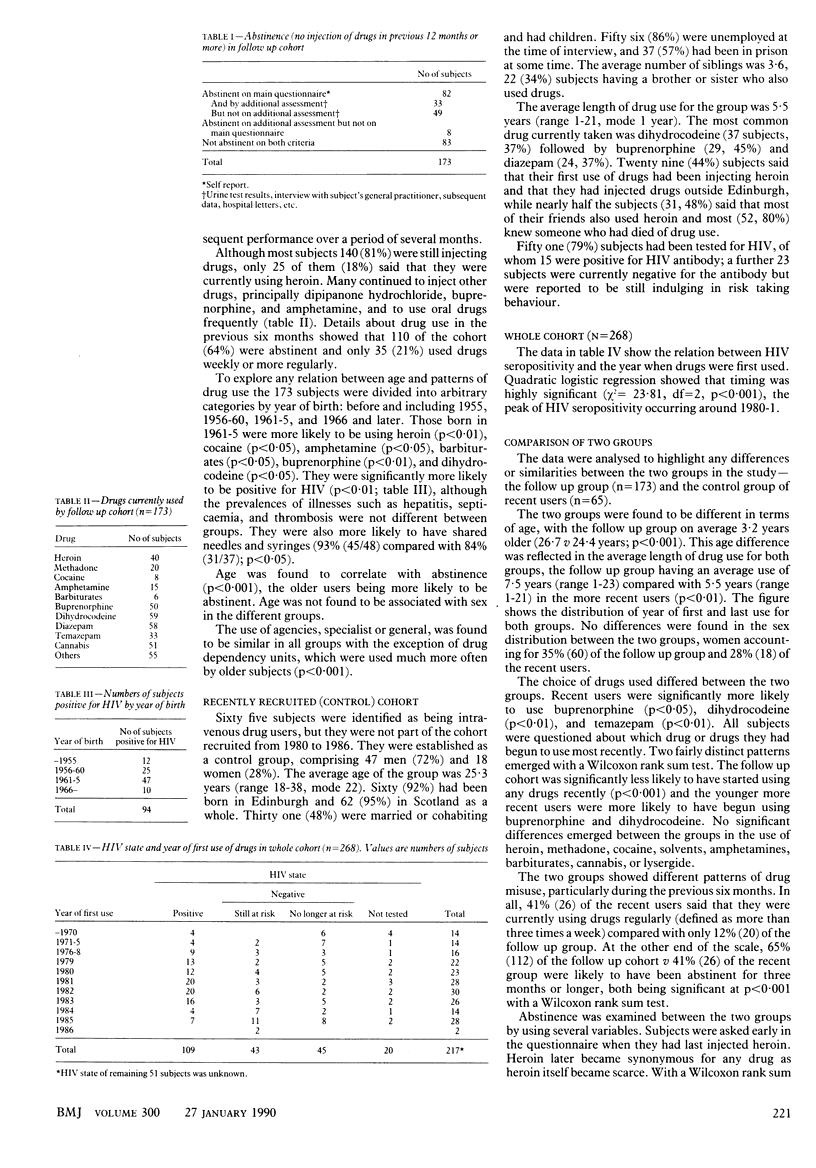
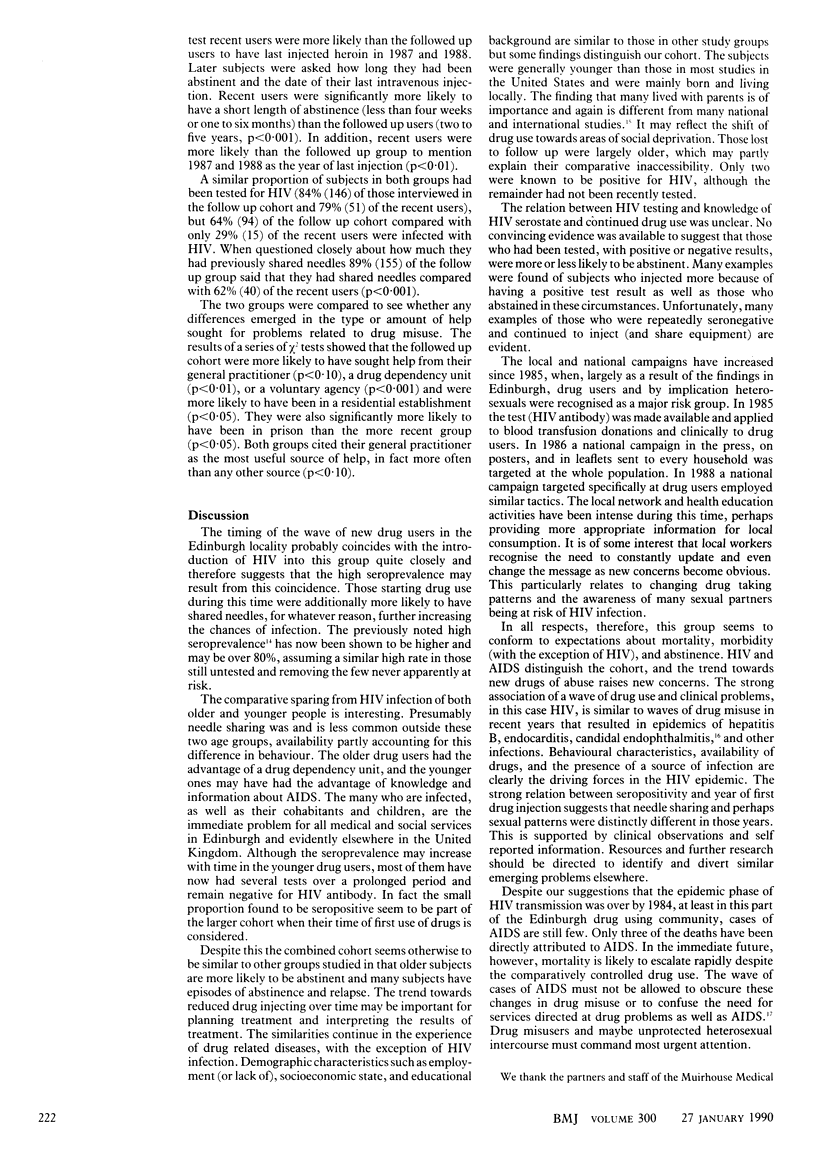
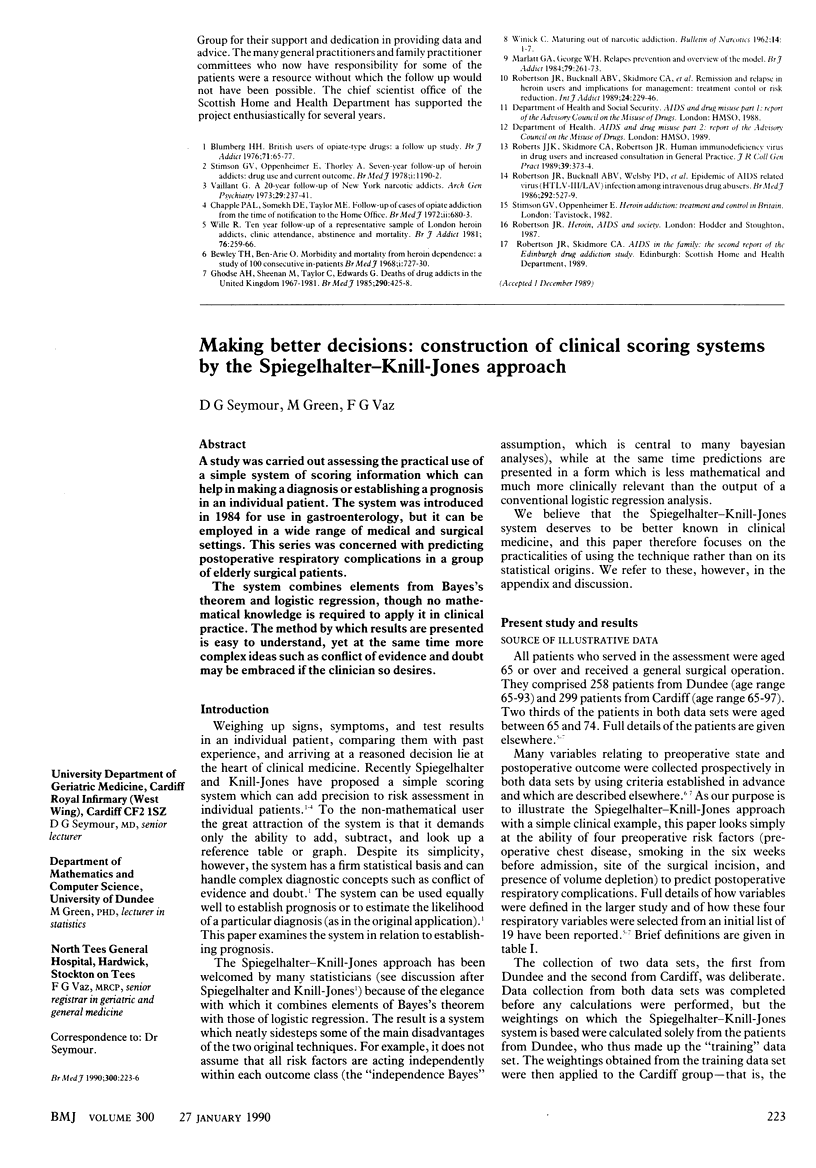
Selected References
These references are in PubMed. This may not be the complete list of references from this article.
- Bewley T. H., Ben-Arie O. Morbidity and mortality from heroin dependence. 2. Study of 100 consecutive inpatients. Br Med J. 1968 Mar 23;1(5594):727–730. doi: 10.1136/bmj.1.5594.727. [DOI] [PMC free article] [PubMed] [Google Scholar]
- Blumberg H. H. British users of opiate-type drugs: a follow-up study. Br J Addict Alcohol Other Drugs. 1976 Mar;71(1):65–77. doi: 10.1111/j.1360-0443.1976.tb00061.x. [DOI] [PubMed] [Google Scholar]
- Chapple P. A., Somekh D. E., Taylor M. E. Follow-up of cases of opiate addiction from the time of notification to the Home Office. Br Med J. 1972 Jun 17;2(5815):680–683. doi: 10.1136/bmj.2.5815.680. [DOI] [PMC free article] [PubMed] [Google Scholar]
- Ghodse A. H., Sheehan M., Taylor C., Edwards G. Deaths of drug addicts in the United Kingdom 1967-81. Br Med J (Clin Res Ed) 1985 Feb 9;290(6466):425–428. doi: 10.1136/bmj.290.6466.425. [DOI] [PMC free article] [PubMed] [Google Scholar]
- Marlatt G. A., George W. H. Relapse prevention: introduction and overview of the model. Br J Addict. 1984 Sep;79(3):261–273. doi: 10.1111/j.1360-0443.1984.tb00274.x. [DOI] [PubMed] [Google Scholar]
- Roberts J. J., Skidmore C. A., Robertson J. R. Human immunodeficiency virus in drug misusers and increased consultation in general practice. J R Coll Gen Pract. 1989 Sep;39(326):373–374. [PMC free article] [PubMed] [Google Scholar]
- Robertson J. R., Bucknall A. B., Skidmore C. A., Roberts J. J., Smith J. H. Remission and relapse in heroin users and implications for management: treatment control or risk reduction. Int J Addict. 1989 Mar;24(3):229–246. doi: 10.3109/10826088909047286. [DOI] [PubMed] [Google Scholar]
- Robertson J. R., Bucknall A. B., Welsby P. D., Roberts J. J., Inglis J. M., Peutherer J. F., Brettle R. P. Epidemic of AIDS related virus (HTLV-III/LAV) infection among intravenous drug abusers. Br Med J (Clin Res Ed) 1986 Feb 22;292(6519):527–529. doi: 10.1136/bmj.292.6519.527. [DOI] [PMC free article] [PubMed] [Google Scholar]
- Stimson G. V., Oppenheimer E., Thorley A. Seven-year follow-up of heroin addicts: drug use and outcome. Br Med J. 1978 May 6;1(6121):1190–1192. doi: 10.1136/bmj.1.6121.1190. [DOI] [PMC free article] [PubMed] [Google Scholar]
- Vaillant G. E. A 20-year follow-up of New York narcotic addicts. Arch Gen Psychiatry. 1973 Aug;29(2):237–241. doi: 10.1001/archpsyc.1973.04200020065009. [DOI] [PubMed] [Google Scholar]
- Wille R. Ten-year follow-up of a representative sample of London heroin addicts: clinic attendance, abstinence and mortality. Br J Addict. 1981 Sep;76(3):259–266. doi: 10.1111/j.1360-0443.1981.tb00232.x. [DOI] [PubMed] [Google Scholar]


